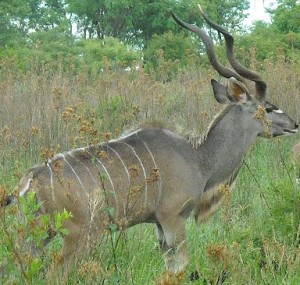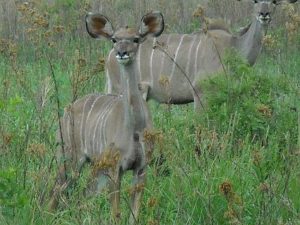About Us
Traveling Geeks is a consortium of entrepreneurs, thought leaders, authors, journalists, bloggers, technology innovators and influencers who travel to countries to share and learn from peers, governments, corporations, and the general public to educate, share, evaluate, and promote new, innovative technologies. The initiative was founded by Renee Blodgett and Jeff Saperstein in 2008.
Trips are funded by sponsorships from corporations, organizations and governments. The first tour was sponsored by the Israel Ministry of Foreign Affairs, a trip that successfully marked the proof of concept that could expand to other countries around the world.
Read More!Khwa ttu: Sustainable Cultural Preservation
The surprise highlight of this trip for me so far hasn’t been a helicopter flight, luxury resort, or journey down three and half kilometers to the world’s deepest mine. No, what has impressed me the most was a lunch-time visit to !Khwa ttu, a culture and education center for the San people of Southern Africa that sustains its operations through a tourism lodge and restaurant.
!Khwa ttu’s restaurant and gift shop.
Trip out on this: if you trace your ancestry from your parents to your parent’s parents and their parents and so on for thousands of generations (back 60,000 years ago), then you’ll find that you share a direct ancestor of this man:
That’s Andries, a 30-year-old from the ‡Khomani community of the Kalahari who learned how to become a tour guide at !Khwa ttu. Along with his colleague Kerson, Andries taught us how to pronounce the klicks and klacks of the various San languages.
Video by Simon Barber.
After our lesson in Khoi and San languages we were shown the following video about the making of the photographic exhibit “The San and the Camera.” The Khoi and San peoples have long been exoticized on the covers of travel pamphlets, in museum exhibits, and in movies like The Gods Must Be Crazy. But their current reality, marked frequently by discrimination and poverty, is ignored by most media.
You can see a more general video about the !Khwa ttu center on their website. What has me excited about the project is that it is able to preserve dying cultures and languages, generate jobs, teach new skills, and educate others all while staying sustainable from its tourism revenue.

If you ever visit Cape Town I highly recommend taking the hour drive to !Khwa ttu to check things out. Their meals are delicious, the photographic exhibit is impressive, and the staff are absolutely lovely. Plus, you’d be supporting a very good cause. Now we just need to get them blogging. ![]()
Game On at Plumari Conservation Reserve
I’ve never experienced anything quite like sharing a sunrise with the large game animals of Africa. Riding in an open air Jeep, we bounced along for three hours and encountered herds of giraffe, kudu (nice ears buddy!) wildebeests, and red hat antelope.
We also encountered two female as well as the one male lion on the preserve. The rains from the previous night left the “roads” muddy, forcing us to abandon the Jeep and push it out of the muck. Forget the need for caffeine when you’re hoping to get your vehicle moving while .
We also encountered a few zebra, oryx, water bug (another kind of antelope), gazelles, warthogs, plovers, and oh-soo-cute baby jackals.
According to our guide, Ansele Benjamin, all of the species except for the oryx were native to the Magaliesberg region. It was stunning to see giraffe gallop across the plain in the orange light of the early morning sun. Benjamin said the lions mostly fend for themselves by preying on kudu and water bugs as they want to allow the animals to live as naturally as possible. The lions were raised in captivity and aren’t fully up to snuff in hunting, so occasionally they are given meat. Invasive species of plants and trees that were brought in by farmers are being taken out to return the environment to its native state.
Most of the species had been driven out over the centuries because of farming and wars, including major battles of the Boer War in the early 20th century. Author Vincent Carruthers, who I had the privilege of hearing speaking, has written about how the region has played a major party in determining South Africa’s history because of the conflicts that took place between native, German and dutch troops.
Look for more pictures to come on Flickr.
Eight Nama Dancing
More from the banks of the Orange River. This is a truly wonderful place. Our host was Johan De Waal of Richtersveld Tours. Pictures of where he took us, and who we met, follow.
Change in South African Housing
Here is a choppy and quick video that compares the current state of “shantytown” housing in Soweto with the homes that are being built to replace them. Eric, a local, narrates.
The shantytown section is particularly short, so go through the video a couple of times to see the difference. Also keep in mind that this settlement looked much better than most of the others that we’ve seen. Shacks are spaced farther apart and seem to be in better condition than the norm.
The improvements in infrastructure – water, sewage, electricity – will be even more important than what is considered the increase in dignity in moving out of the shacks. The government can’t build them fast enough, however, and there have been reports that many if not most of the new homes are sub-standard.
South African Sounds by Day and Night
Soothing sounds of nature from the Plumari Lodge, only an hour from the metro area of Johannesburg which houses over eight million people.
Children Dance in the Richtersveld
Take a look at South Africa’s Richtersveld as seen through the eyes of Nama children, who danced for us on the banks of the Orange River, along the Namibian border.
It was followed by a picnic lunch consisting of grilled fish, game stew, salads and cheese……and of course, a taste of the local beer. You’ll be incredibly moved and if the dancing alone doesn’t bring on a smile, the face below most certainly will. See if you can find her in the videos.
Videos of their performance below:
South Africa’s Joule Electric Car

Optimal Energy CEO Kobus Meiring Presenting the Joule Electric Car
Who Killed the Electric Car? is a 2006 documentary which shows the roles of American automobile manufacturers, the oil industry, and the US government in stopping production of electric cars in the US, specifically the General Motors EV1 of the 1990s. That turned out to be bad news, both for General Motors and American consumers, but it also opened up opportunities for electric car manufacturers abroad.
Optimal Energy, a Cape Town-based company, is trying to position itself as a leader in the field with its Joule all-electric vehicle, which was first unveiled two months ago at the 2008 Paris Motor Shop.
We visited Optimal Energy’s offices – scattered throughout an upscale shopping plaza – earlier this week to see a business presentation by CEO Kobus Meiring. He made a convincing case for the Joule, which was summed up nicely by fellow blogger Chris Morrison.
The car itself didn’t really do it for me – I am a much bigger fan of public transportation projects, like South Africa’s 2010 public transport plan, than any mere personal automobile. But what did fascinate me is how Meiring’s career evolution – from developing military helicopters to telescopes to electric cars – is representative of the evolution of South Africa’s engineering field. Now that South Africa is no longer ruled by a White nationalist government focused on strengthening its military, the country’s engineers are able to work on projects and start companies that make a positive social impact.
Going back to my question of trade versus aid, what is the social benefit of investing in a company like Optimal Energy? On the surface such an investment seems promising. Nearly 100 engineers are given jobs to design the cars. South African construction companies are employed to build manufacturing plants. And hundreds of semi-skilled workers are given decent paying jobs to manufacture the vehicles. This largely explains why Optimal Energy’s largest investor is the Department of Science and Technology of the South African government.
But a question by Graeme Addison, a veteran science journalist and one of the organizers of our tour, revealed an obstacle to South Africa’s multicultural integration of engineers and other professionals. In not so many words Addison essentially asked Meiring how many of his engineers are Black South Africans. We didn’t get a figure, but I would assume only a handful. The Black Economic Empowerment program of February 2007 set a quota system which ensures that a certain percentage of managerial and directorial positions are given to non-White South Africans. Addison later told me that this often means that young Black South Africans straight out of university are given managerial positions without ever going through the apprenticeship and training programs which lead to real skills development.
Meiring, however, said there has been a recent increase in the number of Black engineers graduating from universities and thinks that integration in the field of engineering is progressing. Still, I think that so-called philanthro-capitalist foundations could do a great thing by investing in Optimal Energy, but with the clause that they must hire and train more Black and female engineers. Such an investment could derive both a large social and economic return.
And Optimal Energy sure wouldn’t mind the extra capital. A post written last month by Domenick Yoney says the recent financial collapse has stalled the Joule’s launch and that Meiring and company will need to raise another $130 million before they are able to build an assembly plant and get their product on the road.
You can listen to an MP3 of Meiring’s entire presentation on the Brand South Africa Blog.
DeBeers offshore Diamond Mine: Peace in Africa
It’s a very unusual feeling. Rocking back and forth, back and forth and back again. No land in sight and a boat that has been cut in two and rebuilt with an actual mine in the middle beneath your feet.
The rocking back and forth can be dealt with via a strong stomach and some […]
Cape Town by the sky
I finally managed to string together the video of my trip around Cape Town via the sky.
The helicopter ride (my first) was smooth and absolutely incredible.
I honestly didn’t ever realise how absolutely stunning and unique Cape Town is until this trip. I envy Cape Town folk and honestly don’t even think that they […]
Greenpoint stadium as seen from the Sky
While taking a helicopter flight around Cape Town I noticed the Greenpoint stadium.
It looks incredible. People tell me that there are some issues right now but from where I was sitting it looked magnificent.
For more content from WeBlogTheWorld bloggers visit the WeBlogTheWorld South Africa website.
Similar Posts:Cape Town by the sky
DeBeers offshore Diamond Mine: […]







